
Have you ever needed formal wear for an occasion and thought, “I’m only going to wear this once; maybe I could order it from an online site and then just return it for a refund the next day?”
It may sound like a good idea at the time, but fraudulent returns cost around $22.8 billion a year. That represents just under 11% of the total amount of returned online purchases.
Now, you need a return policy; customers expect it, and most goods are returned for genuine reasons such as wrong sizes or damage. However, you need to recognize that eCommerce return fraud is a genuine problem that must be tackled.
How do you identify possible eCommerce return fraud, and, perhaps more importantly, how do you prevent it?
What Is eCommerce Return Fraud?
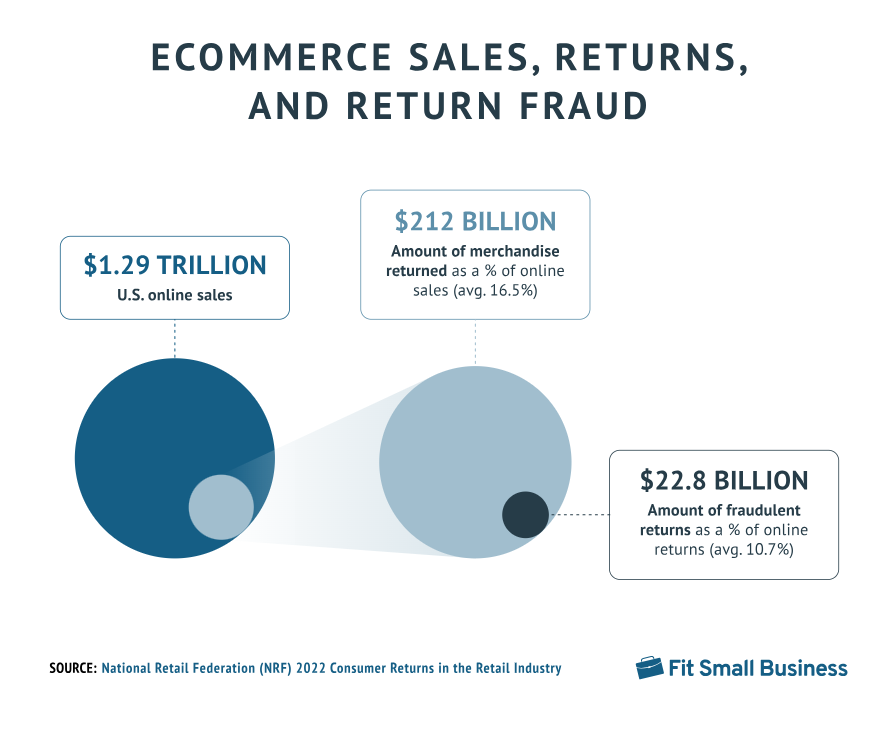
Source: Fit Small Business
Every eCommerce business has some form of refund/return policy. How flexible those policies are will vary from business to business. Return fraud occurs when customers take advantage of that policy, resulting in costs to the business, either in the form of financial loss or damaged inventory.
With so many things to consider in eCommerce, such as retargeting strategies, warehouse management, and shipping and delivery policies, you want to minimize losses where possible.
Now, spotting returns fraud is nowhere near as simple as spotting a shoplifter in a physical store. You have to recognize that most customers returning goods do so for genuine reasons. However, you also need to acknowledge that a percentage of returns may be fraudulent, so you need strategies to identify and prevent fraudulent cases.
Types of eCommerce Return Fraud
The first step in building a strategy against returns fraud is knowing the most common ways customers will attempt to take advantage of your returns policy. By knowing these, you can flag cases when they arise and investigate further to see if it is a genuine return or an attempt at fraud.
1. Wardrobing
Wardrobing is one of the most common types of return fraud and refers to when a customer buys a product but only intends to use it temporarily before returning it to you for a refund. While this fraud often happens within the clothing sector, it can happen with any product.
It will be challenging to identify a one-off offender, but you should flag repeat offenders who often return goods shortly after buying them and investigate further. While most people who return goods may be genuine, many will be wardrobing, and you should look at taking action when you identify them.
2. Friendly Fraud
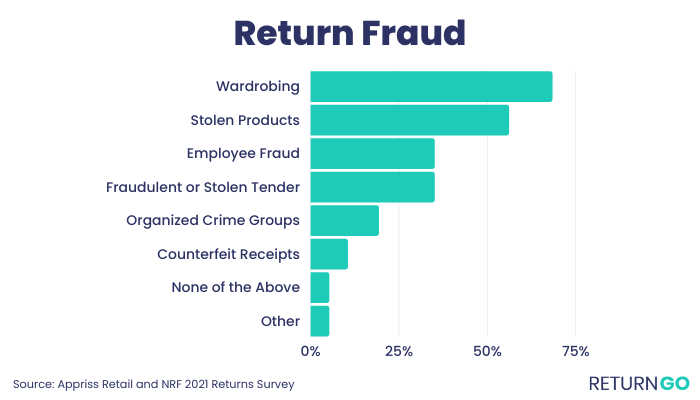
Source: ReturnGO
This almost seems like a misnomer. After all, is any attempt at fraud friendly? “Friendly” fraud happens when a customer orders any product from you but later claims that they never ordered the product or that it was not received. This may be done for financial gain by reselling the items if happening frequently or just to keep for themselves.
Of course, one thing that can prevent this from happening is signed-for deliveries. But how often does a delivery driver find no one in and leave the parcel by the door or on the porch? It can be difficult to prove fraud if you don’t have proof of delivery. When doing friendly fraud, the customer usually asks for a refund, claiming they never received the goods.
3. Credit Card Fraud
Unsurprisingly, this is one of the most common types of eCommerce return fraud. With this particular fraud, someone gets hold of legitimate credit card details (this could be achieved in several ways, such as theft). They then make purchases from you using those stolen details, claim a refund, and get any payment processed via a different card.
Fraudsters have a limited time to carry out this type of fraud. It will depend on how long it takes for the card owner to notice their card is missing (and then report and block it) or how long it takes them or their bank to notice and flag suspicious activity. Thankfully, banks take card fraud very seriously, and their systems will notice if unusual spending patterns occur on a customer’s card.
4. Deliberate Fraud
Individuals or organized crime groups may perpetrate this type of fraud. The fraudsters may create multiple accounts, order goods, then return empty boxes (or filled with sand or similar) to get a refund. This leaves them with the goods they “purchased,” which they can sell for significant financial gain.
This can be difficult to spot unless your refund policy does not issue repayment until the goods have been returned and checked.
5. Influencer Fraud
While influencers may not be solely responsible for this form of fraud, they are a definite driver. With this type of return fraud, people will order a product and then take several pictures of them using or wearing it before returning it and claiming a refund.
Social media influencers can be pressured to keep up with trends, so this is an easy way for them to be seen in the latest fashions (or using the newest product) without being out of pocket.
How to Identify eCommerce Return Fraud
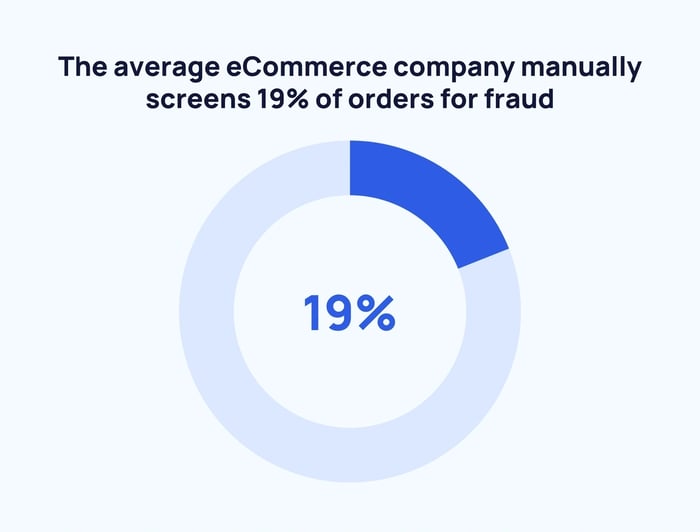
Source: Exploding Topics
It’s one thing to know the most common types of return fraud, but it’s another to spot when they happen to you. Remember, just under 11% of returns are fraudulent, which means that the vast majority of goods returned to you are for genuine reasons. So, how can you use your data to spot possible attempts at fraud?
1. Refunds vs. Exchanges
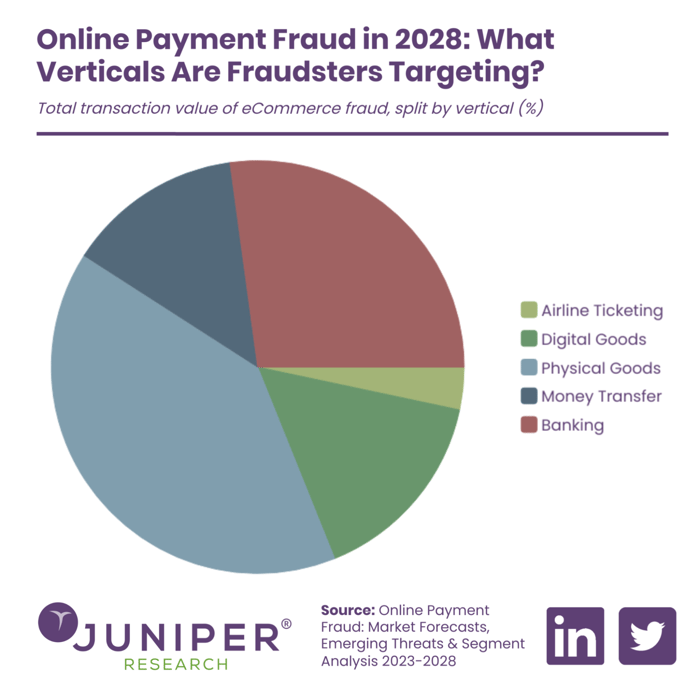
Source: Juniper Research
You can look at this company-wide and use your CRM (customer relationship management) system to identify individual behaviors. When a customer exchanges something you have bought, you still have a sale, though your profit may slightly decrease if you offer a free shipping policy for exchanged goods.
If they ask for a refund, the sale is lost (and you may lose money if free shipping is involved at both stages). Suppose you compare your data on how many refunds were given to how many exchanges were given. In that case, you may see patterns emerge that point to possible fraudulent activity.
2. Look for Seasonal Patterns
There is a good chance that wardrobing may see peaks in particular seasons. After all, some outfits may be only worn once, so the thought process of the fraudster can be, “Why pay for it?”
Identify your company’s seasonal cycles and look at the data to see if you notice spikes in returns and in actual sales.
Depending on what you sell, you should look at the data for different times of the year and different products. For example, sales may increase for dress clothes during graduation season or even in the summer months, when most weddings take place. You will already know what seasonal sales spikes you have; now, look to see if you have similar spikes regarding returns.
3. Segment Your Products
Just as you might look at the segmentation of your customers when it comes to marketing, you can do the same for your products to try and spot fraud patterns. Someone is more likely to try and commit fraud on an item costing $199 than one costing $7.99.
No matter what you sell, consider separating the data for higher-value products from that for low-value products.
4. Look at Other Data
You collect and use an enormous amount of data daily that can be harnessed in various scenarios, such as call center analytics, financial forecasting, and inventory management.
There can be other indicators in your data that may indicate return fraud. These can include lower profits than expected or a loss in your inventory. However, these indicators should not be analyzed in a vacuum, and you should look at different types of data to confirm you have a problem.
How to Prevent eCommerce Return Fraud

Source: demandsage
So, you know the most common types of return fraud and how to identify when it may be happening to you. But how can you be proactive and take steps to prevent it from happening at all (or at least reduce how often it happens) when processing returns?
1. Re-Examine Your Returns Policy
You need a refund/exchange policy, and you want it to be accessible and transparent on your website. You don’t want it to be too complicated because almost 90% of your returns will be legitimate. Have a look at your policy and ensure it contains the following points:
- Proof of Purchase: Customers should have to present some proof of purchase, whether it is the receipt or the confirmation email.
- Time Limits: If something doesn’t fit, a customer should realize that quickly. Put short timeframes for returns to prevent some return fraud.
- Condition: Before issuing a refund, check returned goods for damage, stains, etc. This can be particularly helpful in preventing wardrobing.
- Packaging: Your policy should insist that returned goods come back in the original packaging, including labels and tags.
- Refunds: Your policy should clearly state that any refund will only be processed using the original payment method. This can help prevent the use of stolen credit cards.
2. Use Software
Technology can be an excellent tool when it comes to preventing return fraud. AI-powered software, for example, can identify patterns in real time that indicate fraudulent activity may be taking place. Using algorithms and databases, it can flag high-risk transactions that may indicate fraud. Tied into your CRM, it will instantly identify if a customer’s behavior is unusual.
3. Tighten Your Shipping Policies
You want to be 100% sure the product ordered arrives at the customer’s door. Implement a tracking system that shows you and the customer where the product is. Ensure every product is properly signed for, and disallow the leaving of parcels when no one is in. You can even send the customer an OTP (one-time password) that they need to enter into the delivery person’s device.
4. Ban Offenders
When your systems flag customers potentially committing return fraud, you can investigate them further. You can ban and block that customer if you feel fraud has occurred. If the fraud has involved stolen cards, you can also inform the police. You may end up banning customers who are just serial returners, but you will also significantly reduce return fraud.
5. Run Quality Checks
Many eCommerce businesses offer a pickup service for goods that are being returned. By implementing a quality check at that point, you can help eliminate the sending back of broken goods or empty boxes. Of course, this is something you may want to use only for higher-value products, but it does mean that you can add the item back to your inventory and resell it.
6. Implement Strict Refund Policies
While most of your customers have genuine reasons for requesting a refund, those that don’t can be costly to your business. You can consider adding the following rules to your refund policy:
- Avoid Automation: While automation can be helpful in several areas of your business, such as call routing, it may be unhelpful when issuing refunds. If your system automatically issues those refunds, it could be abetting fraudulent returns.
- Speed: Don’t leave a product sitting in your warehouse when it is returned. Have strict timeframes for the goods to be inspected, processed, and a refund agreed to and issued (or not).
- Reporting: When one of your staff suspects fraudulent activity, have a clear policy regarding how that case can be escalated and reported. Have managers/supervisors whose responsibility is to investigate such cases.
The Takeaway
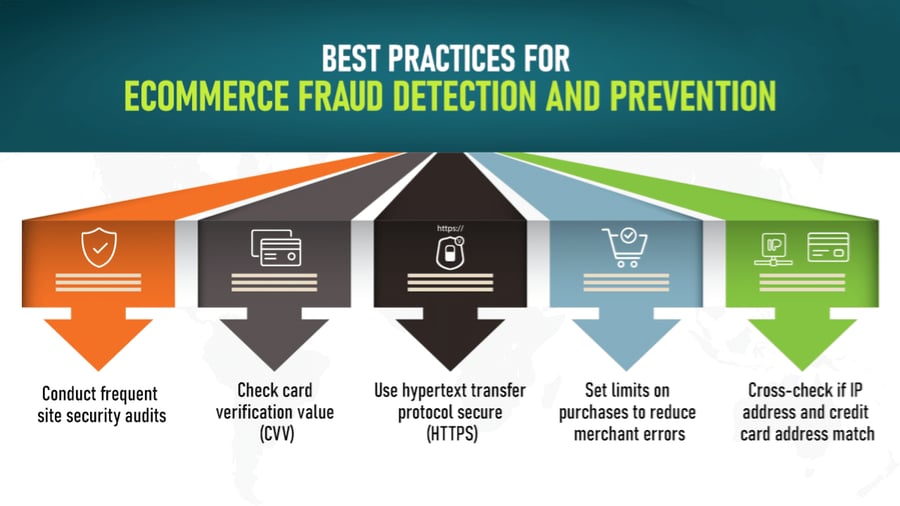
Source: TechReport
A fraudulent returns rate of just under 11% may not sound like much, but for many small eCommerce stores, it can represent a significant loss in revenue and inventory. Even at the enterprise level, it can be a heavy financial burden for a business to bear. While you may never eradicate eCommerce return fraud, you can take steps to reduce it.
The first step is to know the type of return fraud that will most likely target you. For example, a business selling formal wear is more likely to experience wardrobing than a swimwear store. You then need to be able to identify any patterns that emerge from your data and implement policies that can prevent any fraudulent activity from taking place.
By being aware of the tactics used by people in return fraud, you can take steps to ensure that your losses are minimal compared to a business with no protection.






Leave a reply or comment below